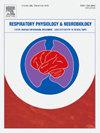肥胖和呼吸症状患儿用力时的呼吸反应和呼吸困难
IF 1.6
4区 医学
Q3 PHYSIOLOGY
引用次数: 0
摘要
我们调查了患有(CWO;n = 25)和没有(CWOO;n = 49)肥胖以及肥胖和呼吸道症状(CWORS;n = 14)的儿童的运动通气反应是否与用力时呼吸困难(DOE)相关。在45 %最大工作速率下骑行6分钟,测量运动通气反应(V / E/V / CO2斜率)和感知呼吸困难评分(RPB, Borg 0-10评分)。V (E) /V (CO2)斜率(CWOO=34 ± 7;CWO = 34 ± 5;CWORS=37 ± 6)和RPB (CWORS=4.0 ± 3.4;CWOO = 2.5 ± 1.7;CWO=3.2 ± 2.1)组间差异无统计学意义(p >; 0.05)。CWORS的V (E) /V (CO2)斜率与RPB之间存在显著相关性(r2=0.49;p <; 0.05)。探讨这种关系更密切,孩子离≤ 2被归类为没有或轻微能源部(DOE; n = 39;强化= 1.2 ±0.7 ),和那些离≥ 3被划分中度到重度的DOE(+能源部;n = 49;强化= 4.7 ±1.9 )。+DOE具有较高的V (E) /V (E) / CO2斜率(+DOE=36 ± 6;-DOE=33 ± 5;p = 0.02)、较高的呼吸频率和较高的V (E) (%max;p <; 0.05)。这些发现表明儿童对通气需求的敏感性提高,并且+DOE可能是由肥胖以外的因素驱动的,可能是运动对通气反应的增加。本文章由计算机程序翻译,如有差异,请以英文原文为准。
Ventilatory response and dyspnea on exertion in children with obesity and respiratory symptoms
We investigated whether the exercise ventilatory response is associated with dyspnea on exertion (DOE) in children with (CWO;n = 25) and without (CWOO;n = 49) obesity, and with obesity and respiratory symptoms (CWORS;n = 14). The ventilatory response to exercise (V̇E/V̇CO2 slope) and ratings of perceived breathlessness (RPB, Borg 0–10 scale) were measured during 6-min cycling at 45 % maximal work rate. The V̇E/V̇CO2 slope (CWOO=34 ± 7; CWO=34 ± 5; CWORS=37 ± 6) and RPB (CWORS=4.0 ± 3.4; CWOO=2.5 ± 1.7; CWO=3.2 ± 2.1) were similar among groups (p > 0.05). A significant association between the V̇E/V̇CO2 slope and RPB in CWORS (r2=0.49;p < 0.05) was observed. To investigate this relationship more closely, children with an RPB≤ 2 were classified as having no or mild DOE (-DOE;n = 39;RPB=1.2 ± 0.7), and those with RPB≥ 3 were classified as having moderate to severe DOE (+DOE;n = 49;RPB=4.7 ± 1.9). +DOE had a higher V̇E/V̇CO2 slope (+DOE=36 ± 6;-DOE=33 ± 5;p = 0.02), higher breathing frequency, and higher V̇E (%max;p < 0.05). These findings suggest a heightened sensitivity to ventilatory demand among children, and that +DOE may be driven by factors other than obesity alone, possibly increased ventilatory response to exercise.
求助全文
通过发布文献求助,成功后即可免费获取论文全文。
去求助
来源期刊
CiteScore
4.80
自引率
8.70%
发文量
104
审稿时长
54 days
期刊介绍:
Respiratory Physiology & Neurobiology (RESPNB) publishes original articles and invited reviews concerning physiology and pathophysiology of respiration in its broadest sense.
Although a special focus is on topics in neurobiology, high quality papers in respiratory molecular and cellular biology are also welcome, as are high-quality papers in traditional areas, such as:
-Mechanics of breathing-
Gas exchange and acid-base balance-
Respiration at rest and exercise-
Respiration in unusual conditions, like high or low pressure or changes of temperature, low ambient oxygen-
Embryonic and adult respiration-
Comparative respiratory physiology.
Papers on clinical aspects, original methods, as well as theoretical papers are also considered as long as they foster the understanding of respiratory physiology and pathophysiology.

 求助内容:
求助内容: 应助结果提醒方式:
应助结果提醒方式:


